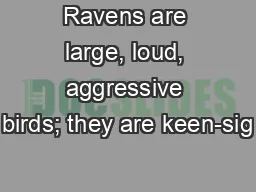

Background ominous wise omens advise sin devil death asking earnestly charming coaxing pale an end long ago gesture of respect manner coward ungraceful awkward songs of mourning trying to figure out ID: 603852
Download Presentation The PPT/PDF document "Ravens are large, loud, aggressive birds..." is the property of its rightful owner. Permission is granted to download and print the materials on this web site for personal, non-commercial use only, and to display it on your personal computer provided you do not modify the materials and that you retain all copyright notices contained in the materials. By downloading content from our website, you accept the terms of this agreement.
Slide1Slide2
Ravens are large, loud, aggressive birds; they are keen-sighted, wary, and usually solitary. They are long-lived and, as pets, may learn to mimic several words. Ravens’ fearlessness and cleverness have earned them admiration. Poe’s raven alights on a bust of the Greek goddess of wisdom, Pallas Athena, whose symbol was the owl. Poe first considered using an owl or parrot as his bird, but chose a raven because of its symbolic associations. We will make note of these associations on the handout you’ve been given.
BackgroundSlide3
ominous
wise
omens
advise
sin
devil
death
asking earnestly
charming, coaxing
pale
an end
long ago
gesture of respect
manner
coward
ungraceful, awkward
songs of mourning
trying to figure out
incense burner
highest-ranked angel
t
emporary relief
anything that causes forgetfulness
old-fashioned charm
k
nowledge, learning
room (often bedroom
produced
beg
sign
shutter
dignified manner
face
said
felt surprised
connection with the topic
peaceful
sinister, threatening
I thought
carpetedSlide4
t
he pattern of end rhyme in a poem
the use of words that sound like their meaning
rhyming words that fall inside a line
repeating of rhymes and of words and phrases, helps create the poem’s rhythm, emphasize ideas
t
he repetition of initial sounds
Masculine: 1 syllable rhymes (heart, part)
Feminine: 2 or 3 syllables (vanity, humanity)
near rhyme (imperfect rhyme – close, but not quite)
object representing something other than itself
a: weary b: door
b: lore b: door
c
: tapping b: more
rapping croaking
tapping shriek
rustling flutteredremember,
December3rd and 4th
lines of each stanza4
th & 5th lines of each stanza – often emphasize key idea
last line of each stanza (hook)l. 45: shorn and shavenl. 71: grim, ungainly, ghastly,
gauntl. 85: evil, devil
l. 87: undaunted, enchantedRaven=pain of losing Lenore (will never leave)
December’s cold=the speaker’s feeling of emotional coldnessSlide5
Stanza
Summary of Events
Other
Notes / Inferences
1
2
3
4
5
6
7
8
9
Reading at midnight, almost nodding off, he hears tapping at the door.
It’s December. He’s trying to read to keep his mind off lost Lenore.
Is Lenore dead
? (
A
ngels name her.)
Why December? Cold, dead (like feelings, Lenore)
He’s frightened but determines it’s surely only a visitor.
Allaying his fear with explanation of sound
He musters his courage and speaks to his visitor, opens the door, and discovers no one there.
He calls out for Lenore into the
darkness (daring to hope she’s alive)
and only hears an echo.
He
goes back inside and hears
the tapping
again—“It’s
just the wind.”
Again trying to allay his fears by justifying the sound
The raven walks
in like he owns the place
and perches above his door on the bust of Pallas.
The raven makes the speaker smile because of its serious attitude.
The speaker guesses it’s sent from the underworld &
asks
it its
name.
The speaker is surprised at the raven’s ability to speak
and notes
how fortunate he is to be visited by a bird named “Nevermore.”
#blessed
What does
the
reply
“nevermore” foreshadow
?
Symbolism=Pallas Athena is goddess of wisdom (The speaker may attribute wisdom to this bird.)Slide6
Stanza
Summary of Events
Other
Notes /
Inferences
10
11
12
13
14
15
16
17
18
He says, “The raven will abandon me, just like everyone else, and like my hopes.” The bird seems to counter that.
He thinks the bird learned the word “nevermore” from an unhappy master, who only knew misfortune.
He is pondering what the bird means by “nevermore.”
Alliteration: grim, ungainly, ghastly, gaunt
He gets distracted by thinking about how Lenore will never again press her head to the cushion.
What personification is used?
He calls himself a wretch for failing to recognize that God sent the bird as a distraction from his pain.
A change in atmosphere = a change in the speaker’s mood
He begs the raven to tell him if he will ever have peace. He says, “Nevermore.”
He pushes further and dares to ask if he will be reunited with Lenore in heaven. The raven again says, “Nevermore.”
Since the bird doesn’t give him an answer he likes, he gets angry and tells the bird to leave. The raven refuses.
The bird will never leave. The speaker will never be able to remove his soul from the bird’s shadow.
The narrator will never again see his love. The raven represents the speaker’s pain over the loss of Lenore.